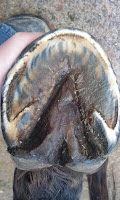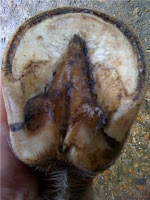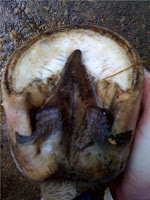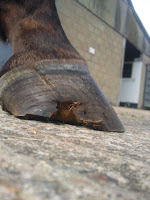


There is none so foolish as he who thinks he can outwit nature













At last the heels in front are starting to decontract. It isn't something that should be forced, you have to listen to the foot, follow the live sole plane and let the foot take the time it needs to heal.
Forcing a foot can make the horse lame or take it in the wrong direction - trust the hoof to know what is needed. But of course, look after the gut to prevent laminitis and treat any foot infections as required. The aim with the trim is to only remove what natural wear would have taken off if the horse were living in an optimal environment with optimal exercise.
The heels on the fronts are arguably too long, but taking them any shorter would mean invading the live sole plane which is unacceptable. The owner has been briefed to look out for the sole turning chalky in the seat of corn area.
Madam has been an interesting case - because if you just looked at the outer hoof wall you'd think her feet were fabulous (and in many respects they are). But it has taken an age to get her feet to this stage and if you look at the undersides with a 'barefooters' perspective you can see that her feet can be better still. And we are not being totally aesthetic here - we are looking for function over form.
I suspect Madam's heel contraction is linked to her sugar intake. We had got them to partly decontract last winter, only to have them close right up again in the summer when she had an overload of sugar. It's something to keep an eye on.









